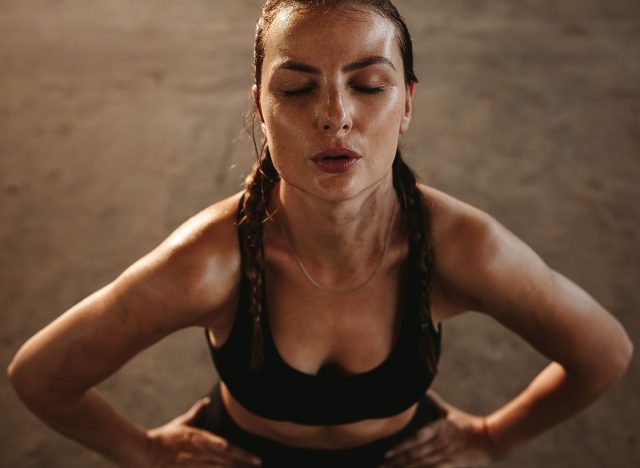Forget Xanax: This Natural Stress Hack Works in Seconds, Expert Says

How we cope with stress varies on a person-by-person basis. Some people soak in a hot tub or sit in a sauna, while others exercise or take medication. However, stress can hit us at the most unexpected times when our go-to methods aren't convenient or available. However, one expert maintains that there is one natural hack you can do anytime, anywhere, to lower stress levels immediately. Risa Sheppard, Master Pilates trainer and creator of The Sheppard Method, whose clients include Reba McEntire, Katherine Ross, and Ali McGraw, explains how taking control of your breathing is the key to lowering stress levels.
Breathing Is More Important Than You Think

"I was once instructing a well-known celebrity on a daytime television show many years ago. I yelled out: 'Breathe!' He turned to me and said, 'Oh, breathing is essential in all parts of life.' We laughed along with the audience, but he spoke the truth. Breathing is essential in all walks of life, and it's not just to keep our hearts and other essential organs alive," Sheppard tells Body Network.
RELATED: I Dropped From a Size 10 to a 4 by Eating These 10 Foods
There Is a Lot of Research Supporting Breathwork for Stress

She maintains that there is a lot of research supporting the benefits of breathwork. "Studies have shown that breathing itself, that thing we do without thinking about it, reduces stress, gives us focus, and helps with not just exercise but many other things as well," Sheppard explains.
Deep Breathing Is Effective for Stress

Here is what to do if you find yourself in a stressful situation — it could be your boss, another work partner, or a social partner, or as simple as things to do on your list that give you anxiety: Don't reach for a Xanax. Instead, "stop and do some deep breaths to calm your system," she suggests. "It works."
RELATED: I Finally Banished Belly Fat in My 40s by Doing These 8 Things
She Recommends the 4-7-8

One of her favorite breathing exercises is the 4-7-8 method. "Breath in for 4 counts, hold for 7 counts, and release for 8," she explains. "Do these 3 or more times depending on the time you have." And do them whenever you can or feel the need to.
It Controls Fight Or Flight Response

"It calms the mind and helps regulate the hormone cortisol, which controls your fight or flight response," she says. "Too much cortisol being released in your body too often can have negative long-term health effects."
RELATED: Tarah Schulte in 2-Piece Workout Gear Reveals How to Lose 20 Pounds in 4 Months with 9 Easy Habits
You Can Do It Anytime, Any Place

Another bonus? Breathwork is super versatile, and it comes in handy in all situations. "You can practice 4-7-8 breathing anywhere at any time," she says. And if you enjoyed this article, don't miss 40 Health Symptoms That Can Be More Serious Than You Think.




